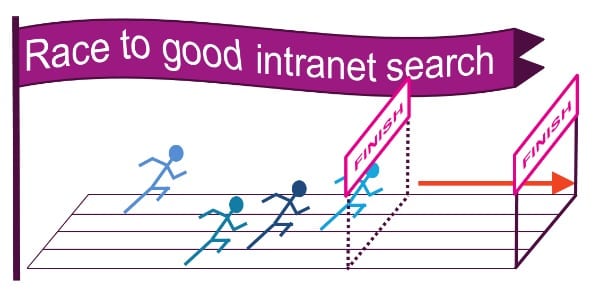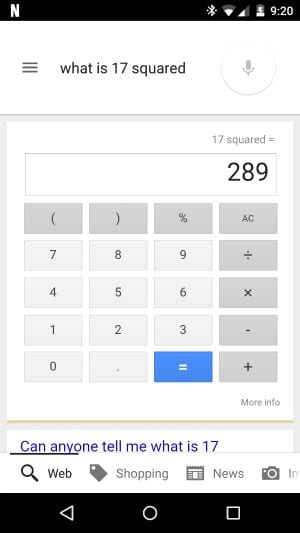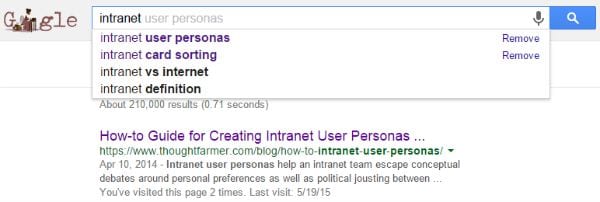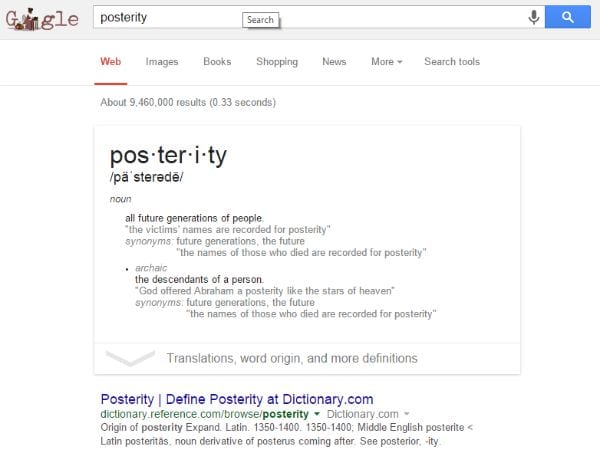7 ways the goal posts on enterprise search have moved

Intranet search has proved a perennial predicament for digital workplace teams. New trends in search are changing expectations for everything from how search results are displayed to the very nature of what search is. This article describes the key trends behind the shifting goal posts. Some people don’t understand the importance of paid adverts in the Google search, but they are pretty important if you are looking to build up a new business as is using Search Engine Optimization Services and strategies.
Search – your white whale
I see a lot of intranets (for example, on Digital Workplace 24 and Digital Workplace Live). I talk to a lot of practitioners in the field (through facilitating intimate, confidential peer learning seminars between digital workplace teams at Fortune 1000 companies on a quarterly basis for the DWG Membership). And I do things like facilitate digital workplace strategy sessions between leading organizations at Microsoft’s Envisioning Lab in Redmond, Washington.
I’m not bragging, I’m just really fortunate that my job includes these cool activities. And it’s things like these that help me occasionally to gain insights into the changing nature of intranets, digital workplaces and modern work as we know it.
And so we come to the topic of enterprise search.
One little word: “search”. Perhaps a satisfyingly complex challenge for you digital workplace managers? Or maybe a thorn in your side? Perhaps your great white whale, the maddening pursuit that will eventually destroy you?
And now, it’s all changing. The goal posts on intranet/enterprise search are moving – the finish line is now further away. The leading examples we’ve seen are now just the midway points on the track.
Why do I say this?
Spotting the narrative told by the leading edge
Below in this article I’ve listed a number of ways in which enterprise search is changing. Not just the ways search results are displayed but the very nature of what search is.
I ended up with this list after an epic journey through the world’s digital workplaces, which included over the course of four weeks:
- 24 hours of digital workplace tours and thought leader interviews for Digital Workplace 24
- A private executive workshop around digital workplace strategy on Microsoft’s campus
- A tour of Microsoft’s Envisioning Lab and discussion of their vision of the near future
- A confidential peer learning seminar in San Francisco with digital workplace managers and teams from more than a dozen major organizations (most of them household brands you know well).
Through these events I saw leading examples of enterprise search, discussed the changing expectations workers have of their digital workplaces and facilitated discussions around key challenges for digital workplace teams.
The topic of search was never far off, and in a culminating stew of intellectual immersion, over-caffeination, conceptual curiosity and pure digital workplace geekiness, I spontaneously threw together on a flip chart the below list of changes in the nature of enterprise search.

The concept of internet search has been around for about 15 years. It has evolved over time and digital workplace managers have tried to keep up. But now, we need to completely reconceptualize what search is and how to do it right.
7 concepts behind the changing nature of enterprise search
#1: Answers, not search results

This concept isn’t new, but it’s a critical starting point. Search is no longer just about seeing a list of results that lead to various linked pages. Google search, along with Google Now and Apple’s Siri, have pioneered the art of delivering answers to humans’ questions, rather than just SERPs (search engine results pages).
Sometimes a searcher does want a list of of web/intranet pages to sift through. But more often than not she wants the answer to a specific question.
Digital workplace managers can no longer afford to be stuck in the mindset of improving search result rankings, but should instead think of search as delivering the answers employees need. This requires increased user testing and observation, data analysis, and putting oneself in the position of users.
#2: Search isn’t one thing

This concept builds upon item #1. Basically, “search” actually refers to a variety of user needs and behaviours, each of which may be asking a different job of the search engine.
There are at least three dualities to understand here:
- Known versus unknown results: Sometimes we use search as a shortcut to destinations or content we are very familiar with. If a user types “timesheets” in your intranet search engine, there’s a good chance she wants to fill hers out, has done it before and just wants to get to the needed page/application quickly. But other times we are looking for something new, or don’t even know exactly what we’re looking for. Search results need to deliver in both of these scenarios.
- Person versus content: This is a simple one, which many of us have experienced in one way or another when trying to manage intranet people directories. Understanding that users may sometimes look either specifically for people or specifically for content is important. Equally important is the realization that sometimes a person thinks they need one of these but actually would benefit from the other. So how are the two linked/integrated?
- Material versus answer: As mentioned above, sometimes people need an answer to a very specific question – for example, related to booking holiday time, an employee might want to know: “What day of the week is Christmas this year?” However, they might need a form for booking vacation time or a list of all paid holidays in a particular country for a new hire. If you can deliver both answers when needed and material when needed, you’re doing your users a massive service.
#3: Learning search

If you use any common web search engine, you know that it remembers sites you’ve visited, terms you’ve searched for and more.
Enterprise search needs to go in this direction too, but it needs to learn in two distinct ways:
- Personalized learning for individual users: Search on the intranet needs to start remembering the activity of each user and creating more and more relevant search results through history-based personalization.
- Learning from analytics for general search tuning: Search engines need to be able to extrapolate patterns from search behaviour, as well as click-through activity on search results, in order to fine-tune search rankings.
This may sound a bit like AI (artificial intelligence), which appears to be around the next corner, but this technology is here today and needed within organizations.
#4: Social filter

Information overload, it’s a real thing.
Digital workplace managers face the challenge of helping users find just what they need in an environment of ever-increasing information.
This has always been a challenge for static intranet content. But more and more user-generated content is entering into the enterprise search corpus through the popularization of enterprise social networks, collaboration platforms, etc.
Digital workplaces are slowly trending towards combining more traditional intranets and social platforms into one site and a consistent user experience. This means that one search experience must span formally managed “official” content as well as less formal project materials and broader social content.
One way to improve relevance of search results is to apply a social filter – to show results that are refined in some way based on the activity of a user’s social network.
Social network data doesn’t just mean people a user “follows” in a “social” platform. It actually lives throughout the enterprise application landscape. Imagine being able to filter a user’s search results based on data about activity of people within their network, such as:
- email conversation participants (email system)
- attendees at meetings (calendar system)
- unit or department members (LDAP or HRIS)
- project team members (project management system; online communities)
- location (LDAP data)
- similar employees (employee profiles on the intranet)
- participants in recent online conversations (collaboration platform), etc.
Internet companies would kill for the amount of user activity and social data lurking within enterprise systems. That information isn’t available on the public web, but is available within enterprises and needs to be taken advantage of in order to deliver more and more relevant content to users.
#5: Understanding intent

To a degree “understanding intent” just summarizes bits from previous items on this list. But it’s an important concept to consider.
Google and other search engines have been figuring this out for a while. When I type a one-word, multi-syllabic noun into the search bar, Google understands what my intent might be: I want a quick definition of the darn word.
Understanding intent can help us differentiate between the different user needs listed in item #2 above (“search isn’t one thing”). This is one of the new perspectives digital workplace managers need to have and a type of analysis that search platforms need to provide.
#6: Results as actions, interacting with results

The idea of interacting with search results is one of the strongest concepts on this list for illustrating that the very nature of search is changing.
No longer is it enough for a search query simply to deliver a page of links. Enterprise search results need to start offering actions and interactions, and even doing so using “typeahead” search while users are entering their search terms.
The most common example of this is in people search results. The above screenshot of a mobile intranet interface from the social intranet vendor ThoughtFarmer shows how live results of a people search include clickable phone numbers and email addresses.
During Digital Workplace 24 we saw how Adobe’s people search shows real-time results with clickable contact details.
Also from Digital Workplace 24, we saw how EY’s search results for people offer hover-over menus that include contact actions (call, message, email) and presence indication.
But that’s just the start. That’s where leading examples are today.
Imagine an employee types “projector request” into the intranet search box. Normally this would lead to a page of search results, but imagine if the live typeahead search brought up the “projector request” form, which the user could then fill out without even leaving the search interface.
Once you let your mind wander down this road, you see a whole new world of opportunity, complexity and challenge.
Basically, “search” becomes an ever more efficient shortcut to completing common employee tasks. We’ve traditionally seen search as offering shortcuts and alternate routes to content, as opposed to clicking through endless site navigation hierarchies.
When you think of the digital workplace as a collection of tasks, rather than content, then search becomes about shortcuts to those tasks.
#7: Source of data for analytics/improvements
Finally, to tie all of the above items in together, we need to recognize the goldmine of data and potential insight that lives within search analytics.
At the aforementioned DWG peer learning seminar (we call them Member Meetings) in San Francisco, one organization said it uses search term trends to identify potential employee engagement issues for HR.
While enterprise search analytics can be mined for insights into improving search results, that’s just the tip of the iceberg. Search analytics can surface:
- User behaviours related to daily work and finding information
- Common tasks users need to accomplish
- Trends in information employees need
- Issues employees are concerned about
- Differing information needs and cultures across geographies
- Organizational issues employees are struggling with.
And the issue isn’t just that digital workplace managers need to seize the opportunity here. Vendors need to continue to deliver stronger and stronger search analytics features, designed not just around what data is available but on the types of questions that need to be answered from the data.
The end of search
To summarize everything above: Search isn’t about search; it’s about finding, connecting, answers, behaviours and productivity.
Some of the above changes are already here within enterprises. Some are still just being tested in the consumer space. But all of them point to a new phase in the life of the internet, intranets, computer technology and the experience of modern, digital work.
So, forget about a search engine. What you need now is a find/answer/action engine. Good luck!
Categorised in: Collaboration, Content management, Digital workplace, Metrics & measurement, Search & findability, Strategy & governance, Usability & design



